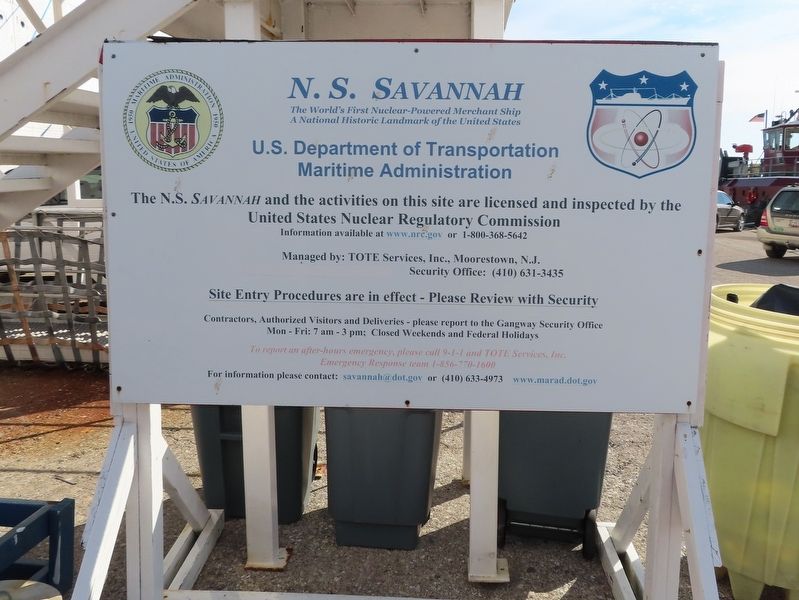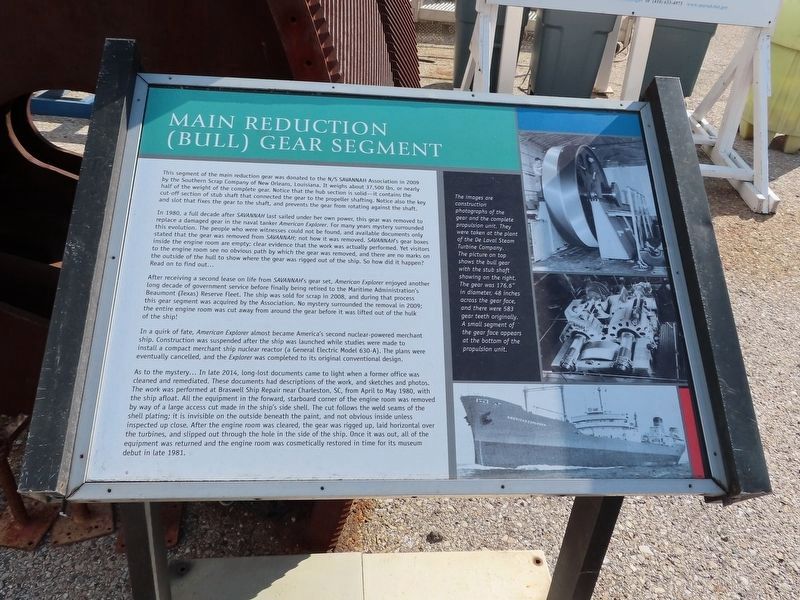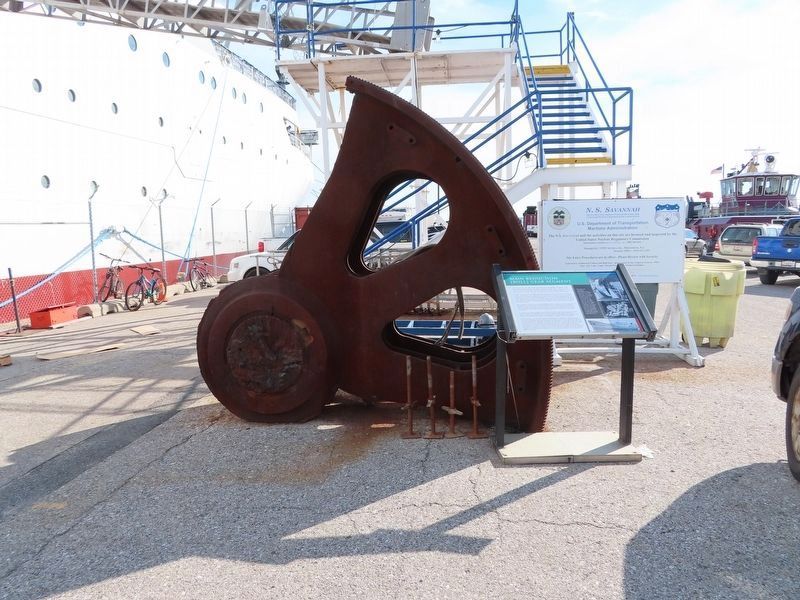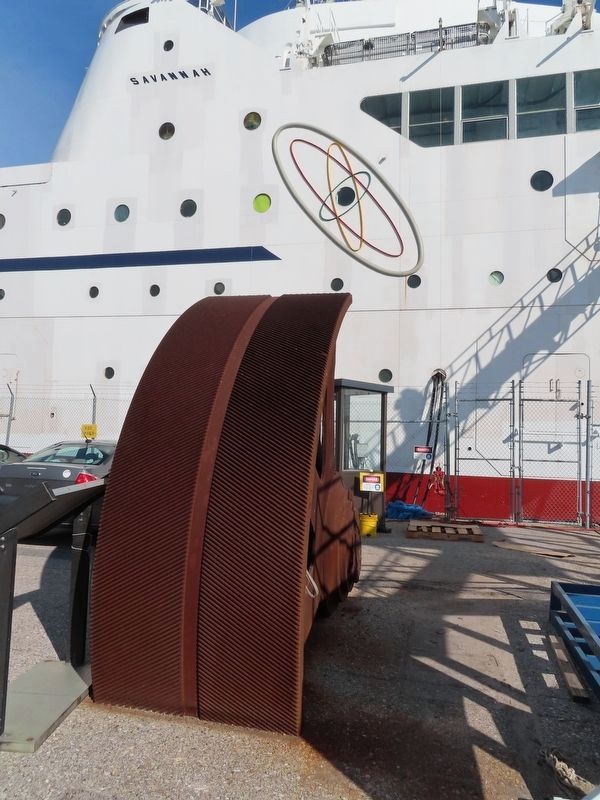Canton Industrial Area in Baltimore, Maryland — The American Northeast (Mid-Atlantic)
Main Reduction (Bull) Gear Segment
This segment of the main reduction gear was donated to the N/S Savannah Association in 2009 by the Southern Scrap Company of New Orleans, Louisiana. It weighs about 37,500 lbs, or nearly half of the weight of the complete gear. Notice that the hub section is solid—it contains the cut-off section of stub shaft that connected the gear to the propeller shafting. Notice also the key and slot that fixes the gear to the shaft, and prevents the gear from rotating against the shaft.
In 1980, a full decade after Savannah last sailed under her own power, this gear was removed to replace a damaged gear in the naval tanker American Explorer. For many years mystery surrounded this evolution. The people who were witnesses could not be found, and available documents only stated that the gear was removed from Savannah; not how it was removed. Savannah's gear boxes inside the engine room are empty; clear evidence that the work was actually performed. Yet visitors to the engine room see no obvious path by which the gear was removed, and there are no marks on the outside of the hull to show where the gear was rigged out of the ship. So how did it happen? Read on to find out...
After receiving a second lease on life from Savannah's gear set, American Explorer enjoyed another long decade of government service before finally being retired to the Maritime Administration's Beaumont (Texas) Reserve Fleet. The ship was sold for scrap in 2008, and during that process this gear segment was acquired by the Association. No mystery surrounded the removal in 2009; the entire engine room was cut away from around the gear before it was lifted out of the hulk of the ship!
In a quirk of fate, American Explorer almost became America's second nuclear-powered merchant ship. Construction was suspended after the ship was launched while studies were made to install a compact merchant ship nuclear reactor (a General Electric Model 630-A). The plans were eventually cancelled, and the Explorer was completed to its original conventional design.
As to the mystery... In late 2014, long-lost documents came to light when a former office was cleaned and remediated. These documents had descriptions of the work, and sketches and photos. The work was performed at Braswell Ship Repair near Charleston, SC, from April to May 1980, with the ship afloat. All the equipment in the forward, starboard corner of the engine room was removed by way of a large access cut made in the ship's side shell. The cut follows the weld seams of the shell plating; it is invisible on the outside beneath the paint, and not obvious inside unless inspected up close. After the engine room was cleared, the gear was rigged up, laid horizontal over the turbines, and slipped out through the hole in the side of the ship. Once it was out, all of the equipment was returned and the engine room was cosmetically restored in time for its museum debut in late 1981.
( photo caption )
The images are construction photographs of the gear and the complete propulsion unit. They were taken at the plant of the De Laval Steam Turbine Company. The picture on top shows the bull gear with the stub shaft showing on the right. The gear was 176.6" in diameter, 48 inches across the gear face, and there were 583 gear teeth originally. A small segment of the gear face appears at the bottom of the propulsion unit.
Topics. This historical marker is listed in this topic list: Waterways & Vessels. A significant historical month for this entry is May 1980.
Location. 39° 15.502′ N, 76° 33.345′ W. Marker is in Baltimore, Maryland. It is in the Canton Industrial Area. Marker can be reached from Newgate Ave., 0.4 miles east of Keith Ave., on the left when traveling east. Touch for map. Marker is at or near this postal address: Pier 13, 4601 Newgate Ave, Baltimore MD 21224, United States of America. Touch for directions.
Other nearby markers. At least 8 other markers are within 2 miles of this marker, measured as the crow flies. Liberty Ship S.S. John W. Brown (within shouting distance of this marker); Lifeboat Number 2 (about 300 feet away, measured in a direct line); M551A1 Sheridan AR/AAV (approx. 1.3 miles away); Army "Sailors," Navy "Soldiers" (approx. 1.3 miles away); The Guns that Won the Battle (approx. 1.3 miles away); You Can Help Save Fort McHenry (approx. 1.3 miles away); A Vast Hospital Once Stood Here (approx. 1.3 miles away); Experimental Carriages (approx. 1.3 miles away). Touch for a list and map of all markers in Baltimore.
More about this marker. Located next to the Nuclear Ship Savannah
Also see . . .
1. N.S. Savannah Association. (Submitted on February 29, 2020, by Michael Herrick of Southbury, Connecticut.)
2. NS Savannah (Wikipedia). (Submitted on February 29, 2020, by Michael Herrick of Southbury, Connecticut.)

Photographed By Michael Herrick, February 19, 2020
4. N.S. Savannah Construction Site
After drydocking in Philadelphia, Savannah is now in Baltimore. All fuel was removed from the ship in October of 1971. She is curently undergoing work to decommission and remove the nuclear reactor. The ship is expected to open to tourists at some point in the future.
Credits. This page was last revised on February 16, 2021. It was originally submitted on February 29, 2020, by Michael Herrick of Southbury, Connecticut. This page has been viewed 238 times since then and 28 times this year. Photos: 1, 2, 3, 4. submitted on February 29, 2020, by Michael Herrick of Southbury, Connecticut.


